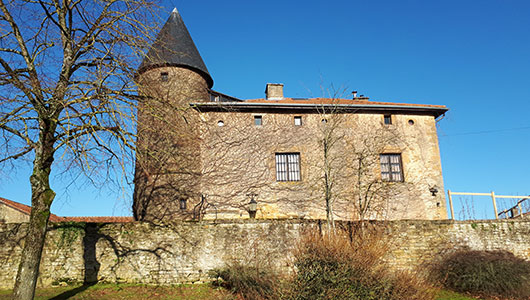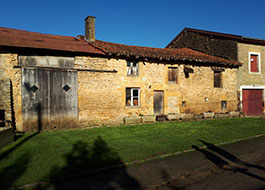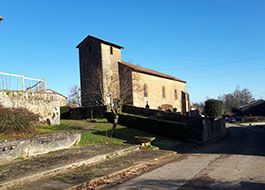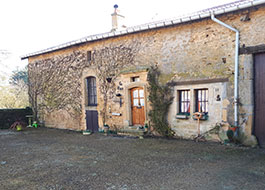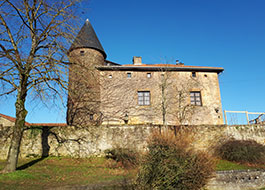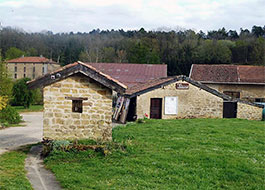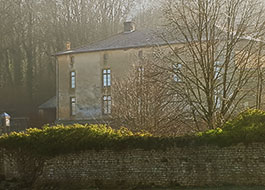Flassigny
Durée visite : 30 minutes
Moyen : Pédestre
Jusqu’au XVIIe siècle Flassigny est séparé en deux parties, pourvues chacune d’un château. Un ruisseau marque la frontière. Flassigny-la-Petite dépend de la prévôté de Saint-Mard. Flassigny-la-Grande relève de celle de Montmédy. La maison des Hautoy et la maison des Gabets de Dombasle se partagent les deux seigneuries. Elles sont réunis par un troisième larron, le seigneur de Reumont. Cette famille compta un habile diplomate, Jean II, qui s’illustra dans les difficiles négociations des traités de Wesphalie, en 1648.
Until the 17th century Flassigny was separated into two parts, each provided with a castle. A stream marks the border. Flassigny-la-Petite depends on the provost of Saint-Mard. Flassigny-la-Grande falls under that of Montmédy. The Hautoy house and the Gabets de Dombasle house share the two seigneuries. They are brought together by a third thief, the Lord of Reumont. This family included a skilful diplomat, John II, who distinguished himself in the difficult negotiations of the Wesphalian treaties in 1648.
Bis zum 17. Jahrhundert war Flassigny in zwei Teile geteilt, die jeweils mit einer Burg versehen waren. Ein Stream markiert die Grenze. Flassigny-la-Petite hängt vom Provost von Saint-Mard ab. Flassigny-la-Grande fällt unter das von Montmédy. Das Hautoy-Haus und das Gabets de Dombasle-Haus teilen sich die beiden Seigneuries. Sie werden von einem dritten Dieb, dem Herrn von Reumont, zusammengebracht. Zu dieser Familie gehörte ein geschickter Diplomat, Johannes II., Der sich 1648 in den schwierigen Verhandlungen über die Wesphalianischen Verträge auszeichnete.

Les habitants de Flassigny s’appellent les Flassigniens et les Flassigniennes.
The inhabitants of Flassigny are called the Flassigniens and the Flassigniennes.
Die Einwohner von Flassigny heißen Flassigniens und Flassigniennes.
Les points de visites
.
Cette belle ferme conserve des caractéristiques typiques. On remarque l’importante porte grangière. Une porte gerbière subsiste au-dessus d’une ouverture obstruée. Là étaient hissés le foin et les grains à l’aide d’une poulie dont on voit encore la poutre de support. En-dessous se trouvait l’étable. Au centre était le logis paysan. On y perçoit tous les bruits de l’écurie et de l’étable, où vivent les animaux à l’attache.
This beautiful farmhouse retains typical characteristics. Note the large barn door. A stack door remains above an obstructed opening. The hay and grain were hoisted there using a pulley, the support beam of which can still be seen. Below was the stable. In the center was the peasant house. In the center was the peasant house. You can hear all the sounds of the stable and the barn, where the animals live.
Dieses schöne Bauernhaus hat typische Eigenschaften. Beachten Sie das große Scheunentor. Eine Stapeltür bleibt über einer versperrten Öffnung. Das Heu und das Getreide wurden dort mit einer Riemenscheibe gehisst, deren Stützbalken noch zu sehen ist. Unten war der Stall. In der Mitte befand sich das Bauernhaus. In der Mitte befand sich das Bauernhaus. Sie können alle Geräusche des Stalls und der Scheune hören, in der die Tiere leben.
Construite entre 1752 et 1759, l’église saint-Martin possède une nef à vaisseau unique précédé d’une tour couverte d’un toit en bâtière. Le cimetière entoure encore l’édifice. Une plaque accolée au mur de l’église rend hommage aux victimes de guerre.
Saint Martin est le patron des maréchaux ferrant, des soldats, des vignerons, des tailleurs, des policiers de France.
Built between 1752 and 1759, the Saint-Martin church has a single nave preceded by a tower covered with a saddleback roof. The cemetery still surrounds the building. A plaque attached to the wall of the church pays homage to the victims of war.
Saint Martin is the patron saint of farriers, soldiers, winegrowers, tailors, police officers of France.
Die zwischen 1752 und 1759 erbaute Saint-Martin-Kirche hat ein einziges Kirchenschiff, dem ein Turm mit einem Satteldach vorausgeht. Der Friedhof umgibt das Gebäude noch immer. Eine an der Wand der Kirche angebrachte Gedenktafel ist eine Hommage an die Kriegsopfer.
Saint Martin ist der Schutzpatron der Hufschmiede, Soldaten, Winzer, Schneider, Polizisten Frankreichs.
.
La maison de la cure située dans la Grande rue date de 1743. Là résidait le curé du village. C’était lui-même souvent un fils de paysan, originaire de la proche région. Ainsi connaissait-il bien la mentalité de ses ouailles. Il subvenait à ses besoins grâce aux dîmes. Elles étaient perçues par l’autorité politique et reversées aux curés. Fixée au dixième de la récolte, la dîme pouvait attendre le septième en Lorraine. Ces dîmes pesaient sur des produits très variés tels que les grains, le vin, les fruits des arbres, les petits des animaux, le foin, le lin, la laine, le chanvre, les fromages. L’exercice de droits si compliqués a occasionné de fréquentes contestations.
The house of the cure located in the main street dates from 1743. There resided the parish priest of the village. He was himself often the son of a peasant, originally from the nearby region. So he knew the mentality of his flock well. He supported himself through tithes. They were collected by the political authority and paid to the priests. Fixed at the tenth of the harvest, the tithe could wait until the seventh in Lorraine. These tithes weighed on a wide variety of products such as grains, wine, fruit from trees, offspring of animals, hay, flax, wool, hemp, and cheeses. The exercise of such complicated rights has given rise to frequent disputes.
Das Haus der Kur in der Hauptstraße stammt aus dem Jahr 1743. Dort residierte der Pfarrer des Dorfes. Er selbst war oft der Sohn eines Bauern, der ursprünglich aus der näheren Umgebung stammte. Also kannte er die Mentalität seiner Herde gut. Er stützte sich durch den Zehnten. Sie wurden von der politischen Autorität gesammelt und an die Priester gezahlt. Der Zehnte wurde auf den zehnten der Ernte festgelegt und konnte bis zum siebten in Lothringen warten.Dieser Zehnte wog eine Vielzahl von Produkten wie Getreide, Wein, Obst von Bäumen, Nachkommen von Tieren, Heu, Flachs, Wolle, Hanf und Käse. Die Ausübung derart komplizierter Rechte hat zu häufigen Streitigkeiten geführt.
.
Cet édifice a été construit à la fin du XVIe à la place d’un ancien bâtiment datant de 1507. La tour d’angle possède un toit coiffé d’une toiture en poivrière. Le château appartenait aux Gabets de Dombasle puis aux Reumont. Des modifications apportées aux XVIIIe et XIXe siècles lui ont conservé malgré tout son cachet originel.
This building was built at the end of the 16th century to replace an old building dating from 1507. The corner tower has a roof topped with a pepperbox roof. The castle belonged to Gabets de Dombasle then to Reumonts. Changes made in the 18th and 19th centuries have retained its original cachet despite all.
Dieses Gebäude wurde Ende des 16. Jahrhunderts als Ersatz für ein altes Gebäude aus dem Jahr 1507 erbaut. Der Eckturm hat ein Dach mit einem Pfefferkastendach. Die Burg gehörte Gabets de Dombasle, dann Reumonts. Änderungen im 18. und 19. Jahrhundert haben trotz allem ihr ursprüngliches Gütesiegel beibehalten.
.
La mairie est installée dans l’ancien lavoir. Il est vrai que le village ne compte que 47 habitants. Mais il semble que leurs opinions sont assez tranchées. En effet, aux élections présidentielles de 2012, lors du premier tour, cette commune a réalisé le score le plus élevé de France pour Philippe Poutou, candidat du Nouveau Parti Anti-capitaliste avec 21,05 % des voix exprimées, contre 1,15% au niveau national.
The town hall is located in the old wash house. It is true that the village has only 47 inhabitants. But it seems their opinions are pretty strong. Indeed, in the presidential elections of 2012, during the first round, this municipality achieved the highest score in France for Philippe Poutou, candidate of the New Anti-capitalist Party with 21.05% of the votes cast, against 1.15% on a national level.
Das Rathaus befindet sich im alten Waschhaus. Es ist wahr, dass das Dorf nur 47 Einwohner hat. Aber es scheint, dass ihre Meinungen ziemlich stark sind. Bei den Präsidentschaftswahlen 2012 in der ersten Runde erreichte diese Gemeinde mit 21,05% der abgegebenen Stimmen die höchste Punktzahl in Frankreich für Philippe Poutou, Kandidat der Neuen Antikapitalistischen Partei, gegenüber 1,15% auf nationaler Ebene.
.
Datant des XVIIIe et XIXe siècles, ce château présente une toiture en tuiles et une façade dotée de nombreuses fenêtres. Il a été construit par les Reumont qui rassemblent à partir de 1722 toutes les terres de Flassigny. La fonction résidentielle l’emporte sur le rôle militaire, que l’on trouve dans l’autre château du village. Deux siècles d’évolution des techniques militaires les séparent. En face se situe la chapelle Saint-Léger. Edifiée vers 1730 par Gabriel de Reumont, elle abrite les sépultures de membres des deux familles seigneuriales du village.
Dating from the 18th and 19th centuries, this chateau features a tiled roof and a facade with many windows. It was built by the Reumonts who brought together from 1722 all the lands of Flassigny. The residential function takes precedence over the military role, which can be found in the other castle in the village. Two centuries of evolution in military techniques separate them. Opposite is the Saint-Léger chapel. Built around 1730 by Gabriel de Reumont, it houses the graves of members of the two seigneurial families of the village.
Dieses Schloss aus dem 18. und 19. Jahrhundert verfügt über ein Ziegeldach und eine Fassade mit vielen Fenstern. Es wurde von den Reumonts erbaut, die ab 1722 alle Länder von Flassigny zusammenbrachten. Die Wohnfunktion hat Vorrang vor der militärischen Rolle, die in der anderen Burg des Dorfes zu finden ist. Zwei Jahrhunderte Evolution in militärischen Techniken trennen sie. Gegenüber befindet sich die Saint-Léger-Kapelle. Es wurde um 1730 von Gabriel de Reumont erbaut und beherbergt die Gräber von Mitgliedern der beiden Familien des Dorfes.

